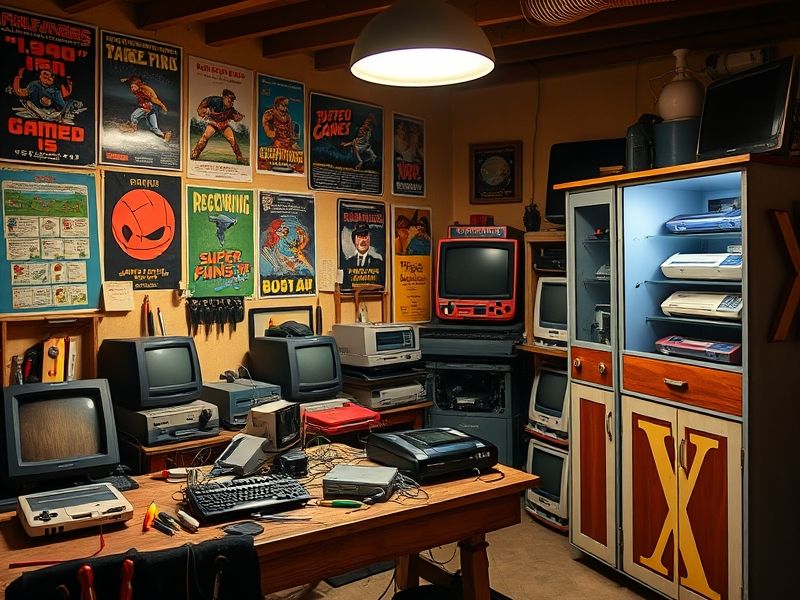Retro oyun konsolları nasıl restore edilir?
- Retro oyun konsolları nasıl restore edilir?
- Breathing New Life into Retro Gaming Consoles: A Comprehensive Restoration Guide
- Assessing the Damage: Know Your Console
- External Inspection
- Internal Assessment
- Cleaning and Repairing the Console
- Cleaning the Exterior
- Repairing Internal Components
- Reassembling and Testing
- Putting it Back Together
- Testing and Troubleshooting
- Conclusion
Breathing New Life into Retro Gaming Consoles: A Comprehensive Restoration Guide
The allure of retro gaming consoles transcends mere nostalgia. It’s a tangible connection to a simpler time, a celebration of pixelated artistry, and a testament to the ingenuity of early game developers. But time takes its toll, and these beloved machines often bear the scars of age: yellowed plastics, corroded connectors, and unresponsive buttons. Fear not, fellow retro enthusiasts! This guide provides a comprehensive walkthrough of the restoration process, equipping you with the knowledge and techniques to revitalize your cherished consoles and bring them back to their former glory. Whether you’re a seasoned tinkerer or a curious novice, restoring a retro console can be a rewarding experience, combining the thrill of hands-on repair with the satisfaction of preserving gaming history.

Assessing the Damage: Know Your Console
External Inspection
Begin your restoration journey with a thorough external examination. Note any physical imperfections like scratches, cracks, or discoloration. Documenting these issues will help you track your progress and ensure you address all necessary repairs. Pay close attention to the condition of the plastic housing. Yellowing is a common problem with older consoles, but it can be reversed with specialized cleaning solutions.
Inspect all ports and connectors for signs of corrosion or damage. Dirty or damaged ports can lead to connectivity issues and prevent your console from functioning correctly. Examine the power button, reset switch, and controller ports, noting any loose or broken parts.
Finally, assess the condition of the console’s labels and stickers. While faded or peeling stickers might seem like a minor cosmetic issue, they can significantly impact the overall aesthetic of your restored console. Consider replacing damaged stickers with reproductions to restore the original look.
Internal Assessment
Once the external inspection is complete, it’s time to delve into the inner workings of your console. Opening the console requires specific tools, so research the necessary equipment for your particular model. Once open, carefully inspect the internal components for dust, debris, and signs of damage. Dust buildup can cause overheating and malfunctions, so thorough cleaning is crucial.
Check the capacitors for signs of leakage or bulging. Capacitors are essential components that regulate voltage, and faulty capacitors can lead to a variety of problems. Replacing old or damaged capacitors is a common practice in retro console restoration.
Inspect the motherboard for any signs of corrosion or damage. The motherboard is the heart of your console, and any issues here can be critical. Look for broken traces, burnt components, or loose connections.
Cleaning and Repairing the Console
Cleaning the Exterior
Cleaning the exterior of your console is the first step in the restoration process. Use a soft, damp cloth to remove dust and grime. For stubborn stains or yellowing, specialized retro-brighting solutions can be used to restore the original color of the plastic. Be sure to follow the manufacturer’s instructions carefully when using these solutions.
Clean all ports and connectors using compressed air or contact cleaner. This will remove any dust or debris that could interfere with connectivity. Pay close attention to the controller ports, as these are often prone to accumulating dirt.
If any labels or stickers are damaged, consider replacing them with reproductions. This will help restore the original look of your console and enhance its overall aesthetic appeal.
Repairing Internal Components
Repairing internal components requires a more delicate approach. Start by carefully cleaning the internal components with compressed air or a soft brush. Remove any dust or debris that has accumulated on the motherboard, capacitors, and other internal parts.
If any capacitors are bulging or leaking, they should be replaced. This requires soldering skills, so if you’re not comfortable with soldering, it’s best to seek professional assistance. Replacing capacitors can significantly improve the stability and longevity of your console.
If the motherboard shows signs of damage, such as broken traces or burnt components, repairs might be more complex. In some cases, it might be necessary to replace the entire motherboard. This can be a costly repair, so carefully assess the extent of the damage before proceeding.
Reassembling and Testing
Putting it Back Together
Once all cleaning and repairs are complete, it’s time to reassemble your console. Carefully reconnect all internal components and ensure that all screws and connectors are securely fastened. Double-check your work to avoid any issues after reassembly.
Before closing the console, test all buttons, switches, and ports to ensure they are functioning correctly. This will save you the trouble of having to reopen the console if something isn’t working properly.
Finally, close the console casing and secure all screws. Your restored console should now look and function like new.
Testing and Troubleshooting
After reassembling your console, it’s time for the final test. Connect your console to a power source and turn it on. If everything is working correctly, you should see the console’s boot screen. Test all buttons, controllers, and game cartridges to ensure they are functioning as expected.
If you encounter any issues, such as a black screen or unresponsive buttons, troubleshoot the problem systematically. Check all connections, ensure the power supply is working correctly, and inspect the internal components for any loose connections or damage.
If you’re unable to resolve the issue, consult online forums or seek professional assistance. There are many online communities dedicated to retro gaming, and you can often find helpful advice and troubleshooting tips from experienced users.
Conclusion
Restoring a retro gaming console is a rewarding experience that allows you to preserve gaming history and reconnect with your favorite childhood games. By following the steps outlined in this guide, you can breathe new life into your old consoles and enjoy them for years to come. Remember to take your time, be patient, and don’t be afraid to seek help when needed. With a little effort and dedication, you can bring your retro gaming consoles back to their former glory and relive the magic of classic gaming.
| Problem | Solution |
|---|---|
| Yellowed Plastic | Retro-brighting solution |
| Dirty Connectors | Contact cleaner |
| Faulty Capacitors | Replacement capacitors |
- Screwdrivers
- Soldering Iron
- Compressed Air
